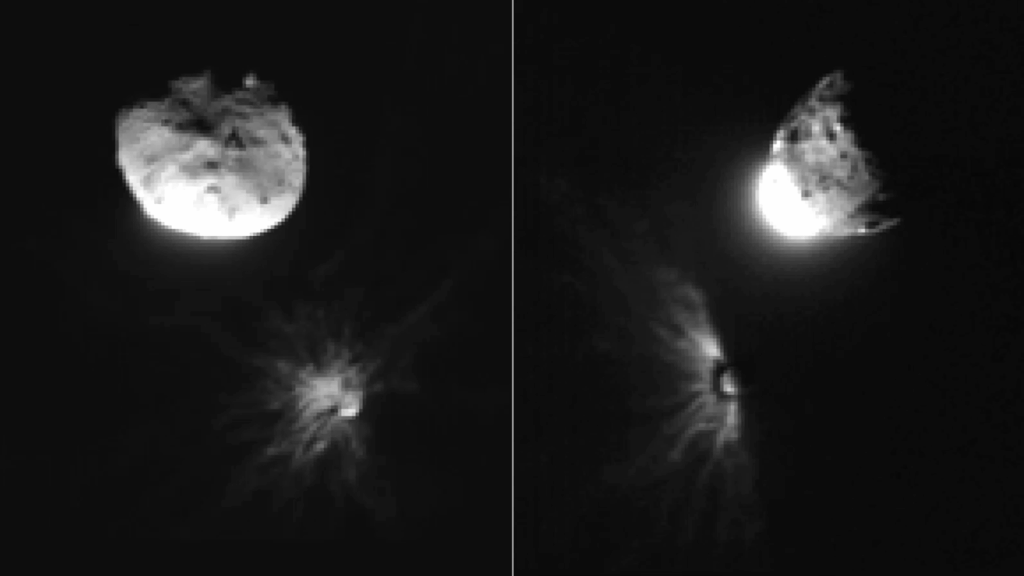
Photos captured by the Italian LICIACube, a cubesat for imaging asteroids, offer the most detailed observations yet of NASA’s DART (Double Asteroid Redirection Test) impact aftermath. Taken just minutes after the collision, these images provide crucial data for planetary defense strategies. The larger body in the images is Didymos, while the smaller, debris-enveloped Dimorphos is the focus of the study.
On September 11, 2022, engineers in Turin, Italy, sent a radio signal into deep space targeting NASA’s DART spacecraft, which was on a mission to alter the trajectory of an asteroid over 5 million miles away. This signal initiated a series of commands that led to the deployment of LICIACube, a small satellite contributed by the Italian Space Agency (ASI).
LICIACube’s Unique Contribution
Fifteen days after its release, LICIACube captured the only on-site images of the DART mission’s historic asteroid deflection. According to a report published on August 21 in the Planetary Science Journal, the impact expelled approximately 35.3 million pounds (16 million kilograms) of dust and rocks from Dimorphos. This finding refines previous estimates based on distant observations.
While the debris represented less than 0.5% of Dimorphos’ total mass, it was 30,000 times greater than the spacecraft’s mass. The rubble’s impact on Dimorphos’ trajectory was significant, giving it a push far stronger than the initial collision.
“The plume of material released from the asteroid was like a short burst from a rocket engine,” said Ramin Lolachi, a research scientist at NASA’s Goddard Space Flight Center.
Implications for Planetary Defense
The DART mission demonstrates that a small spacecraft can significantly alter the path of a “rubble-pile” asteroid like Dimorphos. This type of asteroid is a loose collection of rocks held together by gravity. Dave Glenar, a planetary scientist at the University of Maryland, emphasized the importance of considering the debris plume’s impact when designing future asteroid deflection missions.
The aftermath of the DART impact was observed by NASA’s Hubble Space Telescope, which captured images of the debris tail giving Dimorphos a comet-like appearance. These observations, made from 6.8 million miles away, highlighted the dramatic changes in the asteroid’s orbit.
Understanding DART’s Impact
Dimorphos was chosen as the target for DART due to its orbit around the larger asteroid Didymos. This binary system allowed astronomers to measure changes in Dimorphos’ orbit. Ground and space-based observations confirmed that DART shortened its orbit by 33 minutes, but detailed debris analysis required LICIACube’s close-up images.
LICIACube had only 60 seconds to capture critical images as it sped past Dimorphos at 15,000 miles per hour. The satellite’s proximity allowed it to take detailed images from multiple angles, providing a comprehensive view of the impact plume.
Analyzing the Debris
The research team studied 18 images captured by LICIACube. The images showed the plume’s brightness fading as sunlight filtered through the dense debris cloud, suggesting the presence of larger particles. Using models and data from other asteroid missions, scientists estimated that hidden material accounted for nearly 45% of the plume’s total mass.
“We estimated that this hidden material accounted for almost 45% of the plume’s total mass,” said Timothy Stubbs, a planetary scientist at NASA Goddard.
While DART proved effective in altering an asteroid’s path, Stubbs cautioned that different asteroid compositions might respond differently to similar impacts. “Every time we interact with an asteroid, we find something that surprises us,” he noted, highlighting the need for continued research.
Future of Planetary Defense
The DART mission, managed by the Johns Hopkins Applied Physics Laboratory, marks a significant step forward in planetary defense. As scientists analyze the data, the mission’s success offers valuable insights for future asteroid deflection efforts. The collaboration between NASA, ASI, and other partners underscores the importance of international cooperation in protecting Earth from potential asteroid threats.
Moving forward, researchers will continue to study the data and refine models to improve asteroid deflection strategies. The DART mission’s success not only advances scientific understanding but also enhances global preparedness for potential asteroid impacts.





